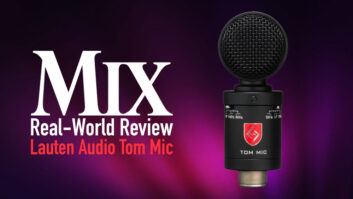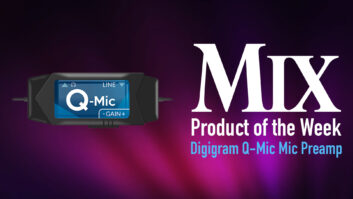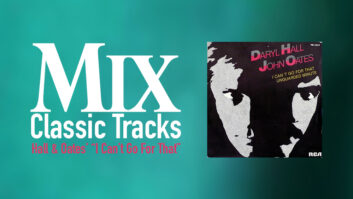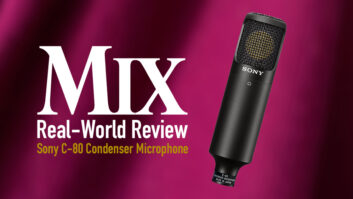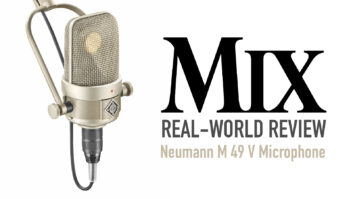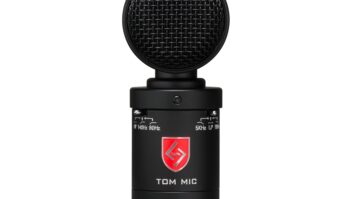
If these two proven, classic condenser mics—the Neumann TLM 103 and AKG C 451 EB—were the only choices available, could they mic the whole band? How does each timeless studio microphone directly compare to the other with a neutral signal path, no signal processing, no pre-conceptions and no hype? Reviewer Rob Tavaglione runs two studio standards through the paces to find out.
Neumann TLM 103

This large diaphragm condenser was first introduced in 1995 as an affordable option to the U87, with its K103 diaphragm based on the K87 diaphragm, although the 103 is transformer-less and cardioid-only, unlike its fully-featured big brother. An exercise in simplicity, the 103 has no switches, pads or other moving/wearing parts. Nickel-plated and shipped with a cherry-wood storage box and swivel mount, the 103 kit is still selling today for around $1,200—a moderately expensive microphone that’s the “affordable model” by Neumann’s lofty standards.
The 103 is rated with an output impedance of 50 ohms (100 ohm recommended load impedance), 20 to 20 kHz frequency response with a broad 4 dB presence rise between 5 and 14 kHz and, most impressively, a ridiculously wide dynamic range. With a maximum SPL rating of 138 dB and self-noise at an industry-leading mere 7 dB, that’s a dynamic range of 131 dB, which is wide enough to capture everything from whispers to weaponry without either noise or distortion.
What the Critics Say: Just check the internet for legions of critics who hate the excessive high-end, sterility and crispness of the 103. Old-schoolers blame the lack of transformer output, others blame the tuning of the capsule. Some compare the 103 to the 87 rather unfavorably…in defiance of even greater legions of Users.
What the Users Say: The 103 is a super popular mic and has been for a quarter century now, attracting many singers, future studio owners and on-the-rise producers as their “first really good mic.” You’ll hear 103s on most of Vampire Weekend’s vocals, the voices of countless rappers, classical instrument recordings, VO artists and clarity-centric jazz recordists.
AKG C 451 EB

Introduced in the late 1970s and discontinued in 1994, the 451 in its various iterations is one of the most popular and utilitarian mics of al- time. With a transformer output, 15 mm diaphragm and classic condenser “pencil mic” design, smooth natural reproduction is the 451’s forte. Its crisp transient capture, nearly flat response (within 1 dB between 20 and 20 k) and solid build quality have made 451s perennial studio and touring favorites.
Even though the C 451B lives on today, the C 451 EB (as tested here) is quite different from the transformer-less current model. The earlier 451s were part of AKG’s Condenser Modular System with interchangeable capsules, the -10 dB KF-2 removable pad (mounted in-between the capsule and mic body), head swivels and even elongated flexible goosenecks. I own a number of 451s, but chose to use a 451 EB body which has two levels of high-pass filter (75 or 150 Hz), no built-in pad (some EB models had switchable -10 and -20 dB pads) and typically a CK-1 cardioid capsule (I also tried a CK-2 omni capsule on a couple of tests).
The 451 is rated with an output impedance of 200 ohms, has a recommended load of 500 ohms, requires 9 – 52 V of phantom power and has about 18 dB of self-noise (notably higher than the 103, as is typical for small diaphragm designs compared to LDCs).
What the Critics Say: The capsule threads and contacts can be fragile and tricky, as many an assistant engineer has been direly warned by their chief engineer. Some say the 451 is too bland—that it sounds ok on everything yet superb on nothing. Others prefer Neumann’s KM84 anywhere you’d use a 451.
What the Users Say: The threads aren’t that sensitive, the switches hold up well and the capsules can take a beating—not to mention that they sound great on anything that is non-amplified. Miking an acoustic instrument you’ve never even heard of before? Have a guest performer coming in with a mystery instrument? Not sure what to get started with? Grab a 451 for starters—they don’t lie and they pair up with ribbons and dynamics beautifully.
Your Next Studio Microphone – The Complete Guide
The Tests
All recording tests were done with industry-standard Apogee Symphony II conversion at 44.1 kHz with 24-bit resolution. Preamps were Cranborne Audio Camden 500s, known for their ultra-linear frequency response, lack of distortion, consistency at all gain levels, dynamic open-ness and lack of noise floor. No signal processing was used other than matching gain on playback, although I sometimes I fiddled with EQ on playback out of curiosity.
I sought to test out each mic in all the typical applications for recording your typical (large) band with drum
s, percussion, bass guitar, electric guitar, acoustic guitar, piano and vocals (and a VO announcer, too, just for the fun of it). Some of these applications wouldn’t exactly be considered “recommended” ones for these mics, but that’s kind of the point here—to objectively give every task a shot and see just how much value can be milked out of these “must have” staples. Hopefully we’ll bust a myth or two, stumble across an unusual-but-good idea and provide some good advice for mic locker builders with tight budgets.

Kick Drum – Wouldn’t normally do this with either mic. Mounted inside, on-axis with the beater, about 8” out. The Neumann TLM 103 sounded thumpy and defined, but had this pronounced shell honk at 350-ish. Meanwhile, the AKG C 451 EB had a nice beater attack, nice shell—a little thin except there were occasional distorted overloads that were deal-breakers. Maybe you could pull the mic back a little bit, add a foam windscreen or try one of those KF-2 pads (unless the diaphragm itself is overloading), but realistically, you can’t do “rock-n-roll kick miking” with a 451.
Snare Drum – The 103 had the most punch and fundamental, but the 451 had the crisp crack of the attack and more harmonics. There was more kick leakage with the 103, but more hi-hat leakage with the 451. That can be problematic, requiring gating and the such, but taping a 451 to a SM57 is a classic studio “trick.”
Drum Overhead – The 103 had a complete full sound, with plenty of low-mid thickness, but a little 400-ish honk. The 451 had that traditional overhead sound, with crisper cymbals and less punchy low-mids. For what it’s worth, with some EQ, I could make them sound almost identical, despite the mics being very, very different on paper.
Floor Tom – Close miked, about four inches out, the 103 sounded great—really punchy, with a nice aggressive attack. The 451 sounded equally as good, but thinner. That’s just right for some folk’s tastes or for corrective use, taming too-thick heads. Again, I could get them about equal with liberal EQ.
Drum Room – I tested this with the 451’s CK2 omni-directional capsule. The 103 had the low-mid power, but the 451 had really natural upper-mids and a little more sparkle. The 103 was more interesting, but the 451 was more realistic. Both could fit into a drum mix effortlessly; it depends on what you’re looking for.
Tambourine – I got more frame and snare-beat “thwack” with the 103, and there was a more bell-ish 10 – 12k with the 451. Both had about equal off-axis pickup, with the response on the 103 sounding a little more subdued and smoother, even if the 451 off-axis tone was flatter. Overall, I preferred the 103, against convention.
Shaker – Both sounded great and nearly identical. There was more swooshy shell 4k with the 103, and more 8k sandiness with the 451. I’d call it equal in quality, although they might sit in a crowded mix quite differently.
Cajon – Both mics were mounted six inches off the floor on the cajon’s front-side. The 103 simply killed it, with more punch and a way more exciting slap; the 451 had flabby lows and boring mids that EQ couldn’t quite invigorate.
Bass Guitar – On my big, fat, tube-driven bass rig, the mics sounded quite similar with more bottom from the 103 and more pick (or finger-attack) with the 451. Both had a totally legit bass sound after EQ that was more powerful than a DI typically captures.
Acoustic Guitar – Both mics were aimed at the juncture of the neck and body, and both sounded absolutely great, with a little more low-mids and boxiness from the 103, and a little more 100 Hz chestiness with 451. The 103 had the 6k bite, while the 451 had the 10 k sparkle. Both could work equally well; it depends on the guitar and/or the song.
Electric Guitar – With both mics just inches off of the speaker, directly on-axis, both handled the extreme SPL. Both sounded really good—about the same on higher pitched chords and thin clean sounds—but the 103 sounded much fuller and complete on lower chords. The 451 sounded almost as good, with a +6 dB bump at 150 Hz.
Piano – With both mics about 2.5’ above the (closed) lid, they sounded way more similar than different in the higher registers. There, the 103 revealed some honk, but got nice deep left-hand stuff with much more power. Despite a less robust presentation, overall, the 451 was plenty warm and full—really the most natural sound overall.
Male Vocals – From about 6” out with a Stedman pop filter and no compression, the 103 sounded complete from chest to lip, with ample 250-ish low-mids and a touch of mid-honk. The 451 had more of a neutral sound, less chest, more natural true-mids and a little more sibilance…but a lot more plosive trouble. A second filter is probably proper for people prone to pronounced plosive popping (see what I did there?).
Male VO – From about 4” out, where proximity effect just started to really completely fill-out, both mics were just slightly off-axis, where high-end nastiness and mouth clicks diminished. The mics sounded nearly identical, with a little more low-mid chestiness 200 Hz with the 103, and a little more accuracy and smoothness in the upper-mids 5-6k with the 451. Using a loud “announcer voice” (pulled back to 7”), the 103 hung in there, but the 451 got too thin and empty. I preferred the 103 overall for voice work.
In the end, it’s clear that both of these mics are extremely versatile—the Neumann TLM 103 was capable of recording the entire band and the AKG C 451 EB struggled only with the kick drum. Both are condensers, and despite that being their only similarity, they both deliver plenty of punch, great dynamics, usable frequency response and the ability to grab a high-quality track regardless of the source. If you’re looking to expand your palette, you can’t go wrong with either of these popular and worthy classics.
Rob Tavaglione owns and operates Charlotte, NC’s Catalyst Recording and has been a longtime studio contributor. www.twitter.com/robtavaglione
